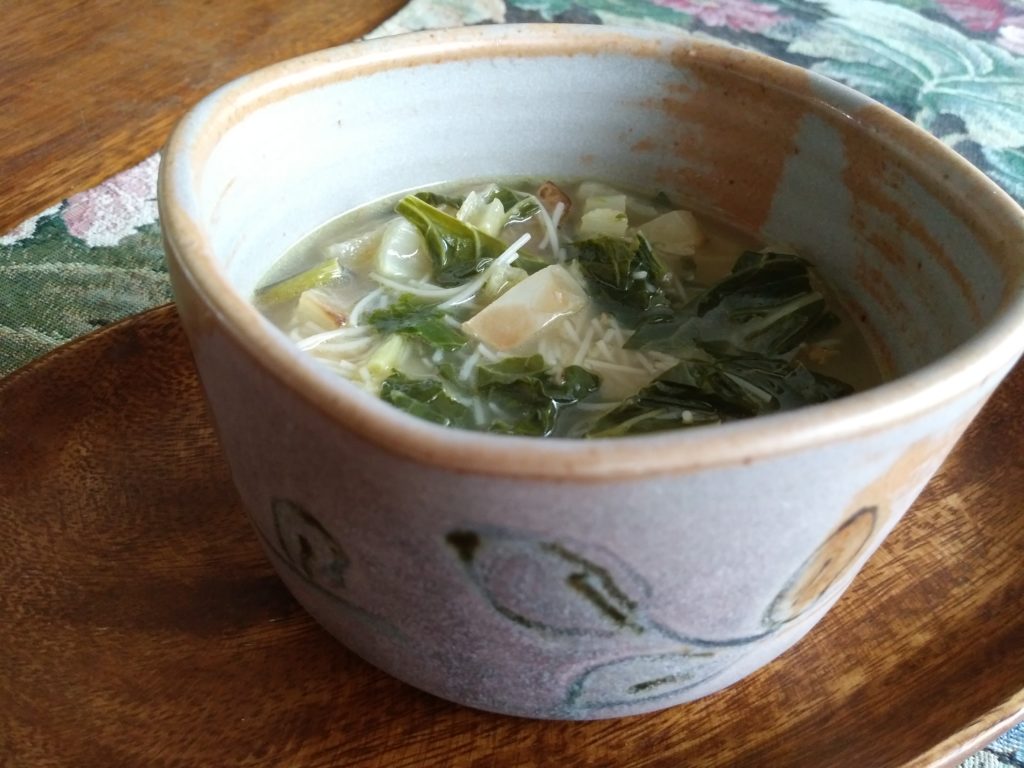
Over the past couple weeks, as autumn has moved into Colorado, I’ve been receiving some pretty strong messages around giving my body a rest: eating a little more lightly, eating less. Of course, being someone who loves to eat, I’ve been fighting that advice tooth and nail, but I’m gradually succumbing to the wisdom and slowing down at the table.
In this connection, miso soup came to mind today as a meal that would be light but also warming and comforting. What’s more, as I began making it, I realized that I was using a couple bitter ingredients–daikon radish and pak choy (an Asian green).
You might have heard about the benefits of eating bitter foods–it’s one of those cool-o fads that is actually hundreds of years old! Many wild–and even cultivated–foods are bitter and if you didn’t want to starve, you ate them, especially since there were few options for sweet fruit smoothies and chocolate cake!
These days, of course, our food supply is filled with sweet foods (even our natural fruits have been bred for super sweetness), so our tastes have become prejudiced and even repulsed by bitter foods. Too bad.
Research is now showing those bitter foods are critical to the proper functioning of our super critical microbiome. What’s more, it should came as no surprise that these real, whole foods have lots of other nutritional benefits as well.(1)
As a transition strategy, don’t just eat bitter foods outright. Cooking can tame them a bit, as can combining them with some sweeter ingredients like miso and rice as in the following recipe.
Recipe: Daikon Radish Miso Soup
Step 1: Saute in a neutrally flavored oil until daikon is lightly browned:
- 2 cups daikon radish, cut in 1/4″ matchsticks about 1” long
- 1-2 cups stems from a large head of Asian greens, like pak choy, bok choy or tatsoi
- 1 Tbsp. freshly grated ginger
Step 2: Stir in and simmer 5-10 minutes until daikon and stems are tender but not mushy:
- 1 qt. high-quality broth, like a bone or mineral broth
- 4-6 cups Chinese greens, chopped roughly about 2″ square
- 1 cup cooked brown rice Maifun (thin, angel hair-style Asian noodles)
Step 3: Spoon about a 2-cup serving into a bowl and then stir in until well-blended:
- 1 to 1½ Tbsp. red miso paste, to taste
- ¼ to ½ tsp. toasted sesame oil (optional)
- ½ to 1 tsp. soy sauce (optional)
NOTE This recipe is written in a simplified format, to show how easy it is to make nutritious meals if you know the building block basics, like:
- how to quickly matchstick radishes
- how to work with greens for best results
- how to grate fresh ginger
- what it means to saute and how the technique builds lovely flavor
- what is miso, the different varieties and how to use miso without destroying its nutritional benefits
- how this recipe can be varied to accommodate whatever veggies are in season and/or in your frig
Not familiar with these building blocks? You’ll want to join the Cook Happy | Live Healthy online program and learn just these kinds of basics. Learn even just a few and you’re set for easy, fun, healthy cooking and delicious meals
(1) “Why you should be eating more bitter foods,” Laura Newcomer / Life by Daily Burn, reposted on NBCNews.com, Dec.22.2017